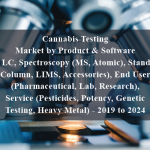OVERVIEW
The Single Cell Analysis Market is currently valued at USD 3.2 billion in 2023 and will be growing at a CAGR of 15.1% over the forecast period to reach an estimated USD 5.62 billion in revenue in 2028. The Single Cell Analysis Market refers to the rapidly growing sector within the life sciences and biotechnology industry that focuses on the examination and manipulation of individual cells. Traditional methods of analysis often involve studying bulk populations of cells, averaging out the characteristics of individual cells within the sample. However, single-cell analysis allows for a more precise and detailed understanding of the heterogeneity among cells, revealing insights into cellular functions, behaviors, and variations that may be masked in bulk analysis. This field has gained prominence with advancements in technologies such as single-cell genomics, transcriptomics, proteomics, and metabolomics, enabling researchers to explore the intricacies of individual cells in unprecedented detail. The applications of single-cell analysis are diverse, ranging from cancer research and immunology to neuroscience and regenerative medicine. As the demand for high-resolution cellular insights continues to grow, the Single Cell Analysis Market encompasses a wide array of products, services, and technologies that cater to the needs of researchers and clinicians aiming to unravel the complexity of biology at the single-cell level. The market includes tools for isolating, analyzing, and interpreting data from individual cells, contributing significantly to advancements in personalized medicine and our understanding of cellular heterogeneity.
The Single Cell Analysis Market is propelled by several key drivers that collectively contribute to its rapid growth and expanding significance in the life sciences and biotechnology sectors. Firstly, technological advancements in single-cell analysis tools and techniques play a pivotal role, offering researchers increasingly sophisticated and high-throughput methods for studying individual cells. The rising focus on precision medicine and personalized therapies is another major driver, as single-cell analysis enables a deeper understanding of cellular heterogeneity, allowing for more targeted and effective treatment strategies. Additionally, the field’s relevance in cancer research has fueled demand, as single-cell analysis helps uncover genetic and molecular variations within tumors, leading to better-informed therapeutic approaches. Moreover, the expanding applications of single-cell analysis in areas such as immunology, neuroscience, and stem cell research contribute to the market’s growth. The increasing collaborations between academic research institutions, pharmaceutical companies, and technology providers also drive innovation and the development of comprehensive solutions. Furthermore, the growing trend towards biomarker discovery and the need for better diagnostic tools contribute to the market’s expansion, as single-cell analysis offers a powerful means of identifying unique cellular signatures. Overall, the Single Cell Analysis Market is propelled by a combination of technological progress, expanding research applications, and the pursuit of more personalized and precise approaches to understanding and treating diseases.
Table of Content
Market Dynamics
Drivers:
The Single Cell Analysis Market is propelled by several key drivers that collectively contribute to its rapid growth and expanding significance in the life sciences and biotechnology sectors. Firstly, technological advancements in single-cell analysis tools and techniques play a pivotal role, offering researchers increasingly sophisticated and high-throughput methods for studying individual cells. The rising focus on precision medicine and personalized therapies is another major driver, as single-cell analysis enables a deeper understanding of cellular heterogeneity, allowing for more targeted and effective treatment strategies. Additionally, the field’s relevance in cancer research has fueled demand, as single-cell analysis helps uncover genetic and molecular variations within tumors, leading to better-informed therapeutic approaches. Moreover, the expanding applications of single-cell analysis in areas such as immunology, neuroscience, and stem cell research contribute to the market’s growth. The increasing collaborations between academic research institutions, pharmaceutical companies, and technology providers also drive innovation and the development of comprehensive solutions. Furthermore, the growing trend towards biomarker discovery and the need for better diagnostic tools contribute to the market’s expansion, as single-cell analysis offers a powerful means of identifying unique cellular signatures. Overall, the Single Cell Analysis Market is propelled by a combination of technological progress, expanding research applications, and the pursuit of more personalized and precise approaches to understanding and treating diseases.
Opportunities:
The Single Cell Analysis Market offers a diverse array of key offerings that cater to the burgeoning demand for high-precision cellular insights in the fields of life sciences and biotechnology. Central to this market are advanced instrumentation and equipment designed for the isolation, manipulation, and analysis of individual cells. Cutting-edge technologies, such as microfluidics and droplet-based systems, enable researchers to examine cellular characteristics at unprecedented resolution. Single-cell genomics tools play a crucial role, allowing for the analysis of the entire genome of a single cell, unveiling genetic variations and heterogeneity within populations. Transcriptomics tools focus on studying the RNA expression profiles of individual cells, providing insights into gene expression dynamics. Proteomics and metabolomics tools contribute to a comprehensive understanding of cellular functions, offering details on protein and metabolite levels at the single-cell level. Additionally, bioinformatics and data analysis solutions are integral, helping researchers make sense of the vast amounts of data generated in single-cell studies. The market also encompasses reagents and consumables specifically formulated for single-cell applications, ensuring accuracy and reliability in experiments. As the demand for personalized medicine grows, diagnostic kits and services based on single-cell analysis are gaining prominence. Overall, the Single Cell Analysis Market’s key offerings span a broad spectrum of technologies and services, collectively empowering researchers to unravel the complexity of cellular biology with unprecedented precision.
Restraints & Challanges:
Despite the significant advancements and growth in the Single Cell Analysis Market, there are several key restraints and challenges that industry participants face. One major challenge is the complexity and cost associated with implementing and maintaining cutting-edge single-cell analysis technologies. The high initial investment required for specialized equipment, reagents, and skilled personnel can be a barrier for smaller research laboratories and institutions. Standardization and reproducibility of single-cell analysis techniques pose another challenge, as variations in protocols and methodologies can impact the reliability and comparability of results across different studies. Additionally, the sheer volume of data generated in single-cell analyses presents computational challenges, requiring robust bioinformatics tools and expertise for effective interpretation. Single-cell analysis often involves the isolation and manipulation of delicate individual cells, and issues related to cell viability, sample contamination, and cell integrity during the process can affect the accuracy of results. Furthermore, ethical considerations regarding the use of human samples and the potential invasiveness of single-cell analysis techniques in clinical settings may pose challenges in terms of regulatory compliance and public acceptance. Addressing these challenges will be crucial for the widespread adoption and success of single-cell analysis technologies, ensuring that the promise of unlocking the intricacies of cellular heterogeneity can be realized across diverse research and clinical applications.
Regional Information:
The Single Cell Analysis Market exhibits notable regional variations, reflecting the global distribution of research and technological advancements in the life sciences and biotechnology sectors. North America stands out as a key hub for single-cell analysis, driven by a robust research infrastructure, substantial investments in biotechnology, and a high prevalence of academic and industrial research institutions. The region benefits from a strong emphasis on personalized medicine and a supportive regulatory environment, fostering innovation and market growth. In Europe, particularly in countries like Germany, the United Kingdom, and Switzerland, there is a significant focus on cutting-edge biotechnological research, contributing to the expansion of the single-cell analysis market. The Asia-Pacific region is rapidly emerging as a crucial player, with countries such as China, Japan, and South Korea investing substantially in life sciences research and biotechnology. The increasing number of collaborations and partnerships between local and international players in the Asia-Pacific region further accelerates market growth. While North America, Europe, and Asia-Pacific dominate the landscape, other regions, including Latin America and the Middle East, also contribute to the overall growth of the Single Cell Analysis Market. These regional dynamics underscore the global nature of scientific research and innovation, with the market’s evolution influenced by a combination of regional research priorities, funding landscapes, and collaborative efforts.
Recent Developments:
• In May 2023, Becton Dickinson & Co. introduced the BD FacsDiscover S8 Cell Sorter, a groundbreaking cell sorting instrument that incorporates two innovative technologies. This state-of-the-art device allows researchers to unveil previously imperceptible details about cells, going beyond the limitations of conventional flow cytometry experiments.
• In June 2022, Merck KGaA partnered with Agilent Technologies to enhance Process Analytical Technologies (PAT), a critical facilitator strongly endorsed by global regulatory authorities. This collaboration aims to propel real-time release capabilities and contribute to the evolution of Bioprocessing 4.0.
Key Players:
Danaher Corporation, Becton, Dickinson and Company, Thermo Fisher Scientific, Inc., Merck KGaA, 10X Genomics, Qiagen NV, Bio-Rad Laboratories, Illumina, Inc., Agilent Technologies, Inc., Standard Biotools, Promega Corporation, Takara Bio Inc.
Frequently Asked Questions
1) What is the projected market value of the Single Cell Analysis Market?
– The Single Cell Analysis Market is expected to reach an estimated value of USD 5.62 billion in revenue by 2028.
2) What is the estimated CAGR of the Single Cell Analysis Market over the 2023 to 2028 forecast period?
– The CAGR is estimated to be 15.1% for the Single Cell Analysis Market over the 2023 to 2028.
3) Who are the key players in the Single Cell Analysis Market?
– Danaher Corporation, Becton, Dickinson and Company, Thermo Fisher Scientific, Inc., Merck KGaA, 10X Genomics, Qiagen NV, Bio-Rad Laboratories, Illumina, Inc., Agilent Technologies, Inc., Standard Biotools, Promega Corporation, Takara Bio Inc.
4) What are the drivers for the Single Cell Analysis Market?
– The Single Cell Analysis Market is driven by technological advances, enabling high-resolution examination of individual cells. Increasing demand for personalized medicine, applications in cancer research, and collaborations across research institutions contribute to the market’s growth. The focus on precise cellular insights propels innovation, expanding the market’s significance in life sciences.
5) What are the restraints and challenges in the Single Cell Analysis Market?
– Key challenges in the Single Cell Analysis Market include high implementation costs, complexity, and standardization issues. Variability in protocols impacts result reliability. Computational challenges arise from the vast data generated. Ethical concerns, regulatory compliance, and potential invasiveness in clinical settings pose additional hurdles, necessitating careful consideration for widespread adoption and success.
6) What are the key applications and offerings of the Single Cell Analysis Market?
– The Single Cell Analysis Market finds diverse applications in genomics, transcriptomics, proteomics, and metabolomics. It plays a crucial role in cancer research, immunology, neuroscience, and stem cell studies. The precision of single-cell analysis is pivotal for advancing personalized medicine, biomarker discovery, and understanding cellular heterogeneity in various biological processes.
7) Which region is expected to drive the market for the forecast period?
– North America is expected to have the highest market growth from 2023 to 2028.
Why Choose Us?
Insights into Market Trends: Global Market Studies reports provide valuable insights into market trends, including market size, segmentation, growth drivers, and market dynamics. This information helps clients make strategic decisions, such as product development, market positioning, and marketing strategies.
Competitor Analysis: Our reports provide detailed information about competitors, including their market share, product offerings, pricing, and competitive strategies. This data can be used to inform competitive strategies and to identify opportunities for growth and expansion.
Industry Forecasts: Our reports provide industry forecasts, which will inform your business strategies, such as investment decisions, production planning, and workforce planning. These forecasts can help you to prepare for future trends and to take advantage of growth opportunities.
Access to Industry Experts: Our solutions include contributions from industry experts, including analysts, consultants, and subject matter experts. This access to expert insights can be valuable for you to understand the market.
Time and Cost Savings: Our team at Global Market Studies can save you time and reduce the cost of conducting market research by providing comprehensive and up-to-date information in a single report, avoiding the need for additional market research efforts.












